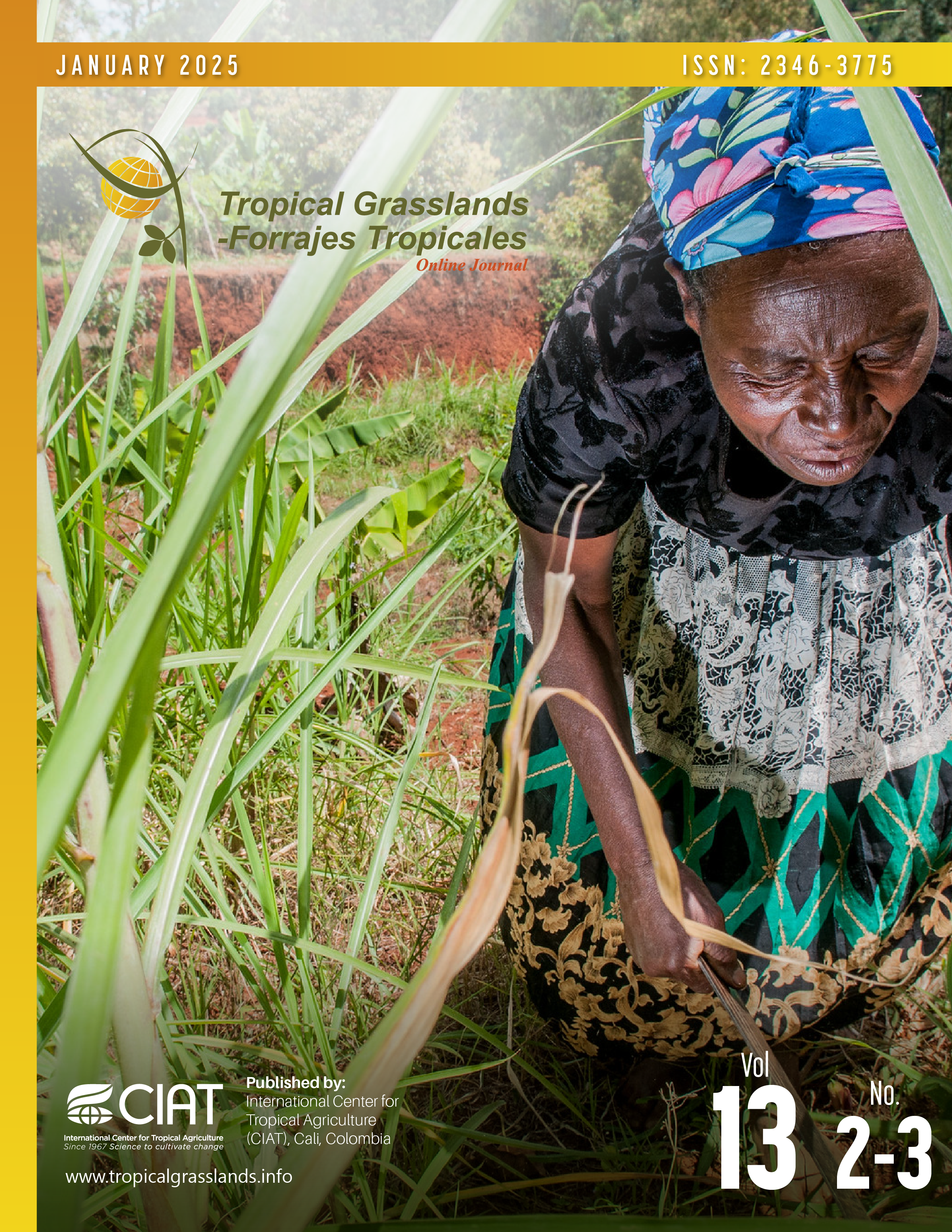Sensibilidad a herbicidas del frijolillo (Desmanthus virgatus) en diferentes etapas de desarrollo
DOI:
https://doi.org/10.17138/tgft(13)94-107Resumen
El Frijolillo (Desmanthus spp.) es una leguminosa nativa, naturalizada o sembrada en muchas áreas tropicales y subtropicales, incluida Australia, donde su uso potencial como leguminosa acompañante se está extendiendo a latitudes más meridionales. El frijolillo se siembra comúnmente en antiguos terrenos de cultivo que tienen una carga significativa de malezas. En estas situaciones, las malezas pueden ser un problema durante la fase de establecimiento, así como en en praderas de frijolillo establecidas. Se llevaron a cabo tres experimentos de campo en el norte de Nueva Gales del Sur para evaluar la sensibilidad de D. virgatus 'Marc' a los herbicidas en diferentes etapas de desarrollo de la pastura. En la siembra, el imazetapir [0.41 kg de ingrediente activo (i.a./ha)] y la trifluralina (0.85 kg i.a./ha) fueron adecuados para uso como preemergente. A las 9 semanas, el bromoxinil (0.14–0.56 kg i.a./ha) y el flumetsulam (0.02–0.08 kg i.a./ha) causaron poco daño a las plantas y son adecuados para su uso, mientras que la 2,4-D amina (0.54–2.16 kg i.a./ha) y el MCPA (0.49–1.95 kg i.a./ha) causaron daños fuertes, reduciendo la producción de forraje y retrasando la floración. En una pastura de 10 meses de edad, el bromoxinil (0.14–0.56 kg i.a./ ha), el imazetapir (0.04–0.14 kg i.a./ha) y la terbutilazina (0.44–1.75 kg i.a./ha) causaron daños menores a corto plazo. El isoxaflutol (0.04–0.15 kg i.a./ha) provocó un blanqueamiento temporal del follaje y una reducción de la producción, sin efectos persistentes tras el corte. Las plantas establecidas de frijolillo fueron defoliadas por paraquat (0.2–0.8 kg i.a./ ha), pero rebrotaron sin efectos fitotóxicos. Todos estos herbicidas pueden utilizarse en plantas de frijolillo. En pasturas establecidas de frijolillo, el 2,4-DB (0.35–1.4 kg i.a./ha) causó daños significativos, pero no la muerte de las plantas. No se observaron efectos persistentes del herbicida en la productividad de las plantas en cortes posteriores.
Biografía del autor/a
Suzanne Patricia Boschma, NSW Department of Primary Industries
Dr Suzanne Boschma is a Senior Research Scientist with NSW Department of Primary Industries based at Tamworth. She has over 20 years’ experience in pasture grass and legume field-based research. Over the last 15 years her research has focussed on tropical grass and legume species and their adaption to northern inland NSW. Sue’s research contributes to providing resilient pasture options to maintain and/or manage feed supply year-round and quantifying and overcoming issues affecting their productivity and persistence. Her research conducted solely and in collaboration, has increased the knowledge of existing and new pasture options in northern NSW
Mark Andrew Brennan, NSW Department of Primary Industries
Mark Brennan is a senior technical officer in the Pastures Unit. He has 20 years research and development experience.
Steven Harden, NSW Department of Primary Industries
Mr Steven Harden is a biometrician with NSW Department of Primary Industries with 35 years experience.
Referencias bibliográficas
Ahmad R; James TK; Rahman A; Holland PT. 2003. Dissipation of the herbicide clopyralid in an allophanic soil: laboratory and field studies. Journal of Environmental Science and Health 38(6):83–695. doi: 10.1081/pfc-120025553
Anonymous. No date. Sakura 850 WG Herbicide. Bayer CropScience Australia Pty Ltd. www.crop.bayer.com.au (accessed 8 February 2024)
Belz RG; Duke SO. 2014. Herbicides and plant hormesis. Pest Management Science 70(5):698–707. doi: 10.1002/ps.3726
Boschma SP; Lodge GM; Harden S. 2011. Seasonal production of lucerne and other perennial legumes and herbs in a summer dominant rainfall zone. New Zealand Journal of Agricultural Research 54(2):105–114. doi: 10.1080/00288233.2011.559252
Boschma SP; Harris CA; Brennan MA; Harden S. 2021a. Medicago sativa and Desmanthus virgatus: suitable perennial legumes in mixes with Digitaria eriantha in Australia during drought. Crop and Pasture Science 72(9):692–706. doi: 10.1071/CP20291
Boschma SP; Harris CA; Brennan MA; Murray C; Baker SJ; Harden S. 2021b. Desmanthus is more persistent than lucerne through drought on the North-West Slopes of NSW. In: Houghton C; Hoare R; Warren H, eds. Proceedings of the 32nd Conference of the Grassland Society of NSW Inc. Grassland Society of NSW Inc., Orange, Australia. p. 82–86. bit.ly/3UYlSxO
Burt RL. 1993. Desmanthus: A tropical and subtropical legume. Part I. General review. Herbage Abstracts 63:401–413.
Cook BG; Pengelly BC; Schultze-Kraft R; Taylor M; Burkart S; Cardoso Arango JA; González Guzmán JJ; Cox K; Jones C; Peters M. 2020. Tropical Forages: An interactive selection tool. 2nd and Revised Edn. International Center for Tropical Agriculture (CIAT), Cali, Colombia and International Livestock Research Institute (ILRI), Nairobi, Kenya. tropicalforages.info
Cox KG. 1998. A study of seed production in desmanthus (Desmanthus virgatus L.). Ph.D. Thesis. Massey University, Palmerston North, New Zealand. hdl.handle.net/10179/2504
Cox KG; Harrington KC. 2005. Selective herbicide strategies for use in Australian desmanthus seed crops. Tropical Grasslands 39(3):171–181. bit.ly/2WNQC7G
Gardiner CP. 2016. Developing and commercializing new pasture legumes for clay soils in the semi-arid rangelands of northern Australia: The new Desmanthus cultivars JCU 1-5 and the Progardes story. In: Lazier JR; Ahmad N, eds. Tropical forage legumes: Harnessing the potential of Desmanthus and other genera for heavy clay soils. CAB International, Boston, MA, United States. p. 283–304. doi: 10.1079/9781780646282.0283
Goetz AJ; Lavy TL; Gbur Jr. EE. 1990. Degradation and field persistence of imazethapyr. Weed Science 38(4–5):421–428. doi: 10.1017/S0043174500056782
Grichar WJ; Ocumpaugh WR. 2007. Bundleflower (Desmanthus bicornutus) response to postemergence herbicides. Weed Technology 21(4):1089–1092. doi: 10.1614/WT-07-011.1
Harris CA; Boschma SP; Murphy SR; McCormick LH, eds. 2014. Tropical perennial grasses for northern inland NSW. 2nd Edition. Future Farm Industries Cooperative Research Centre, Perth, Australia. bit.ly/3qTDWxE
Isbell RF; National Committee on Soil and Terrain, eds. 2021. The Australian Soil Classification. 3rd edition. CSIRO Publishing, Melbourne, Australia. 192 p. bit.ly/423zCLu
Lazier JR; Ahmad N, eds. 2016. Tropical forage legumes: harnessing the potential of Desmanthus and other genera for heavy clay soils. CAB International, Boston, MA, United States 472 p.
Moore CB; Moore JH. 2024. HerbiGuide - The Pesticide Expert on a Disk 2024 V38.0. HerbiGuide, Albany, Australia. www.herbiguide.com.au
Pengelly BC; Conway MJ. 2000. Pastures on cropping soils: which tropical pasture legume to use?. Tropical Grasslands 34(2):162–168. bit.ly/2yb8n6B
R Core Team. 2023. R: A language and environment for statistical computing. R Foundation for Statistical Computing, Vienna, Austria. www.R-project.org/
Reedich LM; Millican MD; Koch PL. 2017. Temperature impacts on soil microbial communities and potential implications for the biodegradation of turfgrass pesticides. Journal of Environmental Quality 46(3):490–497. doi: 10.2134/jeq2017.02.0067
Rosinger C. 2014. Herbicide safeners: an overview. Julius-Kühn-Archiv 443:516–525. doi: 10.5073/jka.2014.443.066
Simko I; Piepho H-P. 2012. The area under the disease progress stairs: calculation, advantage and application. Phytopathology 102(4):381–389. doi: 10.1094/PHYTO-07-11-0216
Vanhala P; Kurstjens D; Ascard J; Bertram A; Cloutier DC; Mead A; Raffaelli M; Rasmussen J. 2004. Guidelines for physical weed control research: flame weeding, weed harrowing and intra‐row cultivation. Proceedings of the 6th European Weed Research Society Workshop on Physical and Cultural Weed Control, Lillehammer, Norway, 8–10 March 2004. p. 194–225. bit.ly/4naFOt4
Vargas-Hernandez M; Macias-Bobadilla I; Guevara-Gonzalez RG; Romero-Gomez SJ; Rico-Garcia E; Ocampo-Velazquez RV; Alvarez-Arquieta LL; Torres-Pacheco I. 2017. Plant hormesis management with biostimulants of biotic origin in agriculture. Frontiers in Plant Science 8:1762. doi: 10.3389/fpls.2017.01762
Wiedman SJ; Appleby AP. 1972. Plant growth stimulation by sublethal concentrations of herbicides. Weed Research 12(1):65–74. doi: 10.1111/j.1365-3180.1972.tb01188.x
Cómo citar
Descargas
Descargas
Publicado
Número
Sección
Licencia
Derechos de autor 2025 Tropical Grasslands-Forrajes Tropicales

Esta obra está bajo una licencia internacional Creative Commons Atribución 4.0.




